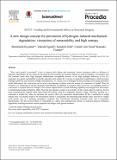A new design concept for prevention of hydrogen-induced mechanical degradation: viewpoints of metastability and high entropy
Author(s)
Koyama, Motomichi; Eguchi, Takeshi; Ichii, Kenshiro; Tasan, Cemal Cem; Tsuzaki, Kaneaki
DownloadPublished version (873.8Kb)
Terms of use
Metadata
Show full item recordAbstract
© 2018 The Authors. "How crack growth is prevented" is key to improve both fatigue and monotonic fracture resistances under an influence of hydrogen. Specifically, the key points for the crack growth resistance are hydrogen diffusivity and local ductility. For instance, type 304 austenitic steels show high hydrogen embrittlement susceptibility because of the high hydrogen diffusivity of bcc (α) martensite. In contrast, metastability in specific austenitic steels enables fcc (γ) to hcp (ϵ) martensitic transformation, which decreases hydrogen diffusivity and increases strength simultaneously. As a result, even if hydrogen-assisted cracking occurs during monotonic tensile deformation, the ϵ-martensite acts to arrest micro-damage evolution when the amount of ϵ-martensite is limited. Thus, the formation of ϵ-martensite can decrease hydrogen embrittlement susceptibility in austenitic steels. However, a considerable amount of ϵ-martensite is required when we attempt to have drastic improvements of work hardening capability and strength level with respect to transformation-induced plasticity effect. Since the hcp structure contains a less number of slip systems than fcc and bcc, the less stress accommodation capacity often causes brittle-like failure when the ϵ-martensite fraction is large. Therefore, ductility of ϵ-martensite is another key when we maximize the positive effect of ϵ-martensitic transformation. In fact, ϵ-martensite in a high entropy alloy was recently found to be extraordinary ductile. Consequently, the metastable high entropy alloys showed low fatigue crack growth rates in a hydrogen atmosphere compared with conventional metastable austenitic steels with α-martensitic transformation. We here present effects of metastability to ϵ-phase and configurational entropy on hydrogen-induced mechanical degradation including monotonic tension properties and fatigue crack growth resistance.
Date issued
2018Department
Massachusetts Institute of Technology. Department of Materials Science and EngineeringJournal
Procedia Structural Integrity
Publisher
Elsevier BV